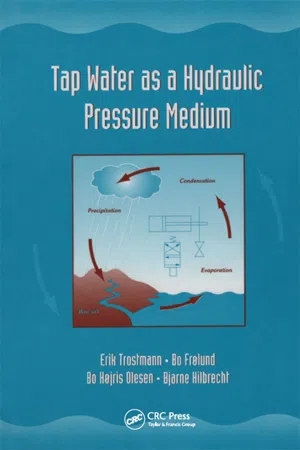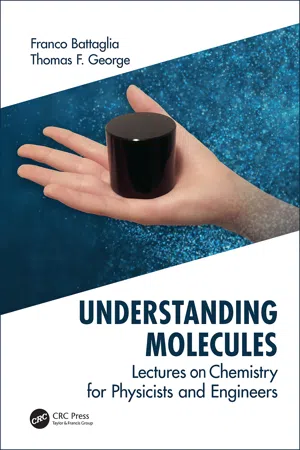Chemistry
Autoionization of Water
Autoionization of water refers to the process by which water molecules can spontaneously dissociate into hydronium (H3O+) and hydroxide (OH-) ions. This occurs when two water molecules transfer a proton between them, resulting in the formation of these ions. The concentration of these ions in pure water is very low, but it is a crucial factor in determining the pH of a solution.
Written by Perlego with AI-assistance
Related key terms
1 of 5
4 Key excerpts on "Autoionization of Water"
- eBook - PDF
- Charlotte W. Pratt, Kathleen Cornely(Authors)
- 2020(Publication Date)
- Wiley(Publisher)
Its chemical reactivity in biological systems is in part a result of its ability to ionize. This can be expressed in terms of a chemical equilibrium: H 2 O ⇌ H + + OH − The products of water’s dissociation are a hydrogen ion or proton (H + ) and a hydroxide ion (OH − ). Aqueous solutions do not actually contain lone protons. Instead, the H + can be visualized as combining with a water molecule to produce a hydronium ion (H 3 O + ): O H H H However, the H + is somewhat delocalized, so it probably exists as part of a larger, fleeting structure such as O O or H H O H H H H H H H O H O H H H H O Because a proton does not remain associated with a single water molecule, it appears to be relayed through a hydrogen-bonded network of water molecules (Fig. 2.13). This rapid proton jumping means that the effective mobility of H + in water is much greater than the mobility of other ions that must physically diffuse among water molecules. Consequently, acid–base reactions are among the fastest biochemical reactions. [H + ] AND [OH – ] ARE INVERSELY RELATED Pure water exhibits only a slight tendency to ionize, so the resulting concentrations of H + and OH − are actually quite small. According to the law of mass action, the ionization of water can be described by a dissociation constant, K, which is equivalent to the concentrations of the reaction products divided by the concentration of un-ionized water: K = [H + ][OH − ] [H 2 O] [2.1] The square brackets represent the molar concentrations of the indicated species. ACID–BASE CHEMISTRY 2.3 KEY CONCEPTS • Water ionizes to form H + and OH − . • An acid’s pK value describes its tendency to ionize. • The pH of a solution of acid depends on the pK and the concentrations of the acid and its conjugate base. + FIGURE 2.13 Proton jumping. A proton associated with one water molecule (as a hydronium ion, at left) appears to jump rapidly through a network of hydrogen-bonded water molecules. - eBook - PDF
- L. Pataki, E. Zapp, R. Belcher, D Betteridge, L Meites(Authors)
- 2013(Publication Date)
- Pergamon(Publisher)
(32) Applying the law of mass action to this equilibrium [ H 3 0 + ] [ O H -] = g [H 2 0P (concentrations rather than activities are used, for simplicity). As the concentration of water in the solution is essentially invariant, this can be simplified to: K w = [H+][OH-] = 1-0 X IO 14 at 25°C (33) where K w is the ionic product of water. In pure water, dissociation according to equation (32) yields hydro-gen ions* and hydroxide ions in equal amounts, hence: [H+][OH-] = [H+p = [OH-]» = K w . or [H+] = [OH] = 1-0 X IO 7 at 25°C. (34) Solutions in which the hydrogen ion and hydroxide ion concentrations are equal are said to be neutral. It follows from this equation that one mole in ten million dm 3 of water is dissociated to ions, that is, only one molecule per 556 million molecules of water is dissociated. Even though their concentration in pure water is extremely small, the pro-ducts of the dissociation, the hydrogen and hydroxide ions, play a very important role in the reactions occurring in aqueous solutions. It also follows that hydrogen ions and hydroxide ions are present simultaneously in water, or in any aqueous solution. The concentra-tion of one of the ions can be varied arbitrarily, but the concentration of the other ion will always assume a value to make the product of their concentrations 1·0χ10~ 1 4 . When an acid is added to an aqueous * Although it has been shown that hydrogen ions are highly solvated in water (§ 1.2.1), for simplicity they are given the symbol H + in the subsequent discussion. 3 20 BASIC ANALYTICAL CHEMISTRY system, the hydrogen ion concentration increases, and the concen-tration of hydroxide ions decreases simultaneously. When a base is added, an opposite process will take place. In the reaction of an acid with a base the hydrogen and hydroxide ions combine to give water until the product of the ionic concentrations reaches the value of K w . - eBook - PDF
- Erik Trostmann(Author)
- 2000(Publication Date)
- CRC Press(Publisher)
The polarity is one of the most significant properties of the water molecule. In liquid "water", the water molecules are attracted to each other due to the slightly negative oxygen and the slightly positive hydrogen. These types of bonds are called hydrogen bonds. The result in liquid water is a matrix of water molecules that are connected through hydrogen bonds (see Figure 4.3). Figure 4.3 Molecular structure and spatial arrangement of water molecules 4.2 Chemistry of pure water Water will result from combustion of hydrogen gas in an oxygen-filled atmosphere. The energy released by the reaction is very high, thus under normal circumstances the combustion is explosive. 90 Bo Hejris Olesen Table 4.1 shows selected temperature values of Kw calculated using this formula. The pressure dependence of the ionisation product constant for water has been studied under various temperature and pressure ranges. The dependency of pressure is less than the dependency of temperature. One of the most relevant studies for the conditions within tap water hydraulic systems covers the range of 5-35°C and 1-2000 bar [Whitfield, 1972]. Table 4.2 shows selected values from this study. Besides the combustion reaction (equation 4.36) the only significant chemical equilibrium that exists in pure water is the autoprotolysis or the ionisation of the water itself. The proton, when formed, will be attached to a water molecule thus, the reaction is more correctly: This reaction is usually called the ion product of water. The degree of water ionisation is reflected in the equilibrium constant for the above reaction Kw. In pure water the activity of the water molecule is said to be unity (1 M), and for the purpose of this section it will be assumed to be so. Thus, in pure water the equation becomes: At 25°C and atmospheric pressure, Kw = 1.01 x 10'14 M2, thus the fraction of ionised water is extremely low. The value of Kw depends on temperature and pressure. - eBook - ePub
Understanding Molecules
Lectures on Chemistry for Physicists and Engineers
- Franco Battaglia, Thomas F. George(Authors)
- 2018(Publication Date)
- CRC Press(Publisher)
– . For instance, a specific and precise balance between these ions is needed for appropriate well-functioning of several enzymes, and a tiny deviation from that balance may sometimes be even fatal. The importance of the subject treated here is therefore crucial. The chapter ends with a brief treatment of the solubility equilibria of insoluble salts.12.1 AUTOPROTOLYSIS OF WATER
We have already announced [(9.1 ) and Problem 11.28 ] that in pure water occurs the equilibriumwhose thermodynamical constant is2H 2O ⇌H 3O ++ OH -,( 12.1 )K ( T ) =.a ¯H 3O +a ¯OH -a ¯2H 2O( 12.2 )It turns out that in pure water, at a temperature of 25°C, the equilibrium concentration of hydroxonium and hydroxide ions, (H3 O+ and OH– , respectively) is [H3 O+ ] = [OH− ] = 10−7 mol/L: the ionic concentration is sufficiently low to give water a very low electric conductivity.In what follows, we shall be interested in the concentration changes of these ions such that the maximum concentration of any of them is less than 1 M. This is a value much lower than the 55.6 moles in 1 L of water; hence, for all changes in the equilibrium (12.1 ) considered here, for what has been said at the end of Section 11.7 , the activity of the species H2 O may be identified with the activity of the pure species (which is equal to 1, since the standard state of the solvent is the state in which it is pure). The activity of the ionic species (solutes), instead, may be identified with the numerical value of their molar fraction; this, in turn, due to the low concentration of these species, is proportional to their molality which, given water as the solvent, coincides essentially with the molarity.PROBLEM 12.1Show that for a dilute solution of a solute in a solvent, the solute molar fraction is proportional to its molality m . [xs≈ (MS/1000)m , whereMS
Index pages curate the most relevant extracts from our library of academic textbooks. They’ve been created using an in-house natural language model (NLM), each adding context and meaning to key research topics.



